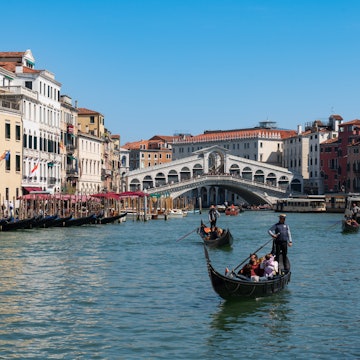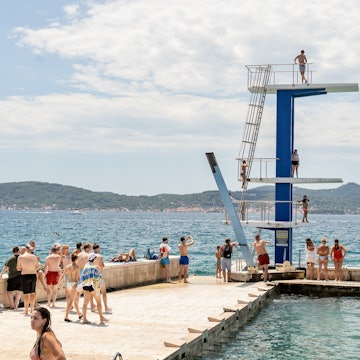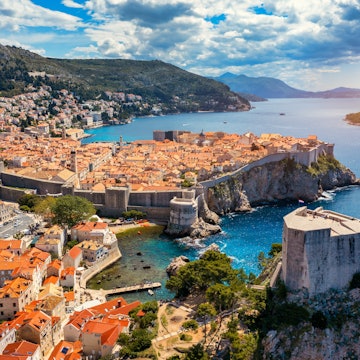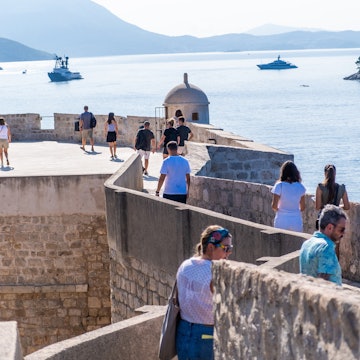

Cruise ships have made hard-to-reach destinations like Antarctica more accessible © DreamPictures / Getty Images
The lure of cruising is easy to understand – sprawling ocean vistas, a salty breeze gently tousling your hair, the promise of exotic locales on the horizon, the temptation of the all-you-can-eat buffet…
In fact, cruising is now more popular than ever, with the Cruise Lines International Association forecasting that a record 30 million passengers would take to the seas aboard a cruise in 2019. No other method of travel makes visiting such a number of worldwide locations (especially hard-to-reach places like Antarctica) so simple and affordable.

The downside? In an era of increasing awareness around sustainability, cruise ships are environmental dinosaurs. Despite ongoing improvements in the industry, the majority of passenger ships still have huge carbon footprints, their fuel pollutes the sea and they contribute directly to overtourism, with cities like Venice and Dubrovnik reporting unmanageable levels of tourist footfall in their ports as a result of visiting ships (leading to some cities imposing limits, or making moves to ban them completely).
So what do you do if you care about the environment but aren’t ready to abandon (cruise) ship? Here are nine personal choices you can make to ensure your cruise experience is as responsible as possible, both on the high seas and on dry land.

Before boarding…
1. Check the cruise liner’s environmental report card
It’s unsurprising that the monolithic, waterborne mini-cities that major cruise liners now resemble are not especially environmentally friendly. From obvious air pollution issues to the question of sewage treatment, the ways in which these ships damage the oceans they traverse are, unfortunately, numerous.
Aiming to put pressure on cruise lines to improve their environmental credentials, Friends of the Earth have produced a ‘report card’ that ranks major operators against different environmental criteria using a simple scoring system. It’s worth checking out the company you’re thinking of booking with to gain a rough idea of how they’re doing, but do take the data with a pinch of (sea) salt – it isn’t always completely up-to-date.
Back up your initial check by scouring the cruise liners’ individual websites for information on their commitment to sustainability. Look for key indicators like how they handle waste water, power usage and emissions, sustainability of on-board food and crew working conditions – asking the company directly on social media can yield a swift response too!
2. Consider a ‘small cruise’ holiday
Although the word ‘cruise’ invariably conjures mental images of gargantuan liners carving through the world’s oceans, the variety of cruise itineraries on offer today is staggering. More companies are introducing ‘small cruise’ holidays, whereby fewer passengers travel on smaller vessels to lesser-known, less busy destinations. Not only do these side-step the issue of popular-port overcrowding, such cruises often run programmes dedicated to investing in local communities and encouraging passengers to spend their holiday fund with local businesses and initiatives.
3. Pack a little extra
As counter-intuitive as it sounds, you can make a positive difference by packing a few extra items in with your chic, cruising wardrobe. The not-for-profit initiative Pack for Purpose encourages holidaymakers to bring along certain items in their luggage, from clothing to stationery, and donate them to civic welfare projects in the destinations they visit. With far less baggage restrictions than air passengers, cruisers are ideal participants in this scheme, and it’s worth checking out which helpful extras you could deliver on your scheduled stops.

While on board…
4. Give the buffet a swerve
Tempting as the smorgasbord of dishes may be, piling up a plateful at the buffet might be one of the least sustainable things to do on a cruise ship. This all comes down to waste. Keeping the array fresh and exciting for three meals daily means an enormous amount of produce, and consequently, an enormous amount of uneaten produce to be disposed of. It’s estimated that around 30% of cruise ship buffet food is thrown away.
Of course, the siren call of the buffet is not only about its ease and variety – buffet meal costs are often included in overall cruise packages. However, making responsible food choices is essential if cruises are to become more sustainable. Instead of heading to buffet town, eat on land wherever possible, seeking out locally run restaurants (ideally away from the port’s main drag), or markets and street food stalls to keep costs down. The more passengers choose to eat away from the buffet, the more cruise companies will look into less wasteful alternatives.
5. Reduce your single-use plastic consumption
This is basic ‘saving the planet’ stuff, but is just as important on a cruise as in your daily life or with any other form of travel – say no to plastic straws, cups and bottles. Packing your own reusable water bottle can save considerable plastic waste, as can bringing your own toiletries. A number of larger cruise liners including Norwegian Cruise Line, Royal Caribbean and P&O have already pledged a fleet-wide, single-use plastic ban, but you should still keep a vigilant eye on the plastic used in your cabin, as well as being conscious of your own usage when on land.
6. Watch your energy and water usage
It’s easy to lose track of your energy and water consumption when you’re in the midst of the holiday of a lifetime. Put your round-the-clock fun on pause just long enough to ensure the lights in your cabin are only on when needed, that you’ve unplugged your electricals, and you’re not using the air-con when you could just open a window (think of the sea breeze!). Save water by shortening showers, and reusing your bed linen and towels so they’re not being washed unnecessarily.

While on dry land...
7. Invest your time and money in local communities
A common criticism directed at the cruise industry is that it fosters a ‘tickbox’ travel culture, leading passengers to simply ‘check off’ the destinations they visit, rather than engaging with them. Additionally, the amount that cruise passengers contribute to the local economies of port cities is hotly disputed and, although port authorities collect hearty docking fees, this cash rarely trickles down to the pockets of ordinary residents.
Buck this trend by making an effort to venture further when ashore. Swap organised tours for independent exploring, choosing to spend your money in locally run restaurants and businesses (such as bike rental shops). Ask locals for tips on where to eat, drink and shop in the area – chances are you’ll have a much more enjoyable and authentic experience.
8. Use Instagram wisely
A report by the Cruise Lines International Association cited Instagram opportunities as an emerging new incentive for a younger crowd to want a piece of that #cruiselife. If you’re keen to document your voyage on the ‘gram, be mindful of how you position it – make an effort to show your authentic adventures on land as much as the ship, include local food experiences in your snaps, and ensure your frames are single-use plastic free. As trivial as it sounds, the influential power of Instagram in 2019 is indisputable. Make sure yours is a force for good.
9. Seek out genuinely sustainable community projects
‘Voluncruising’ is a fast growing trend, offering passengers a chance to ‘give back’ to the destinations they visit. Many cruise lines offer volunteering experiences as part of their packages, with P&O, Crystal Cruises and Carnival Corporation all jumping aboard. As much as the aim of such initiatives is ostensibly noble, research is key to ensuring your well-intentioned efforts will not be misdirected. Often, the large turnover of unskilled cruise passengers shipped in to ‘help’ with various projects can prevent skilled, local workers from being employed. Be sure to ask questions about whether or not you have useful skills to offer, if the projects can show proven positive results, and where your money will be going. The greater the demand for transparency in voluncruising, the more likely companies are to listen and create schemes that genuinely benefit communities, rather than unintentionally cause harm.
Get more travel inspiration, tips and exclusive offers sent straight to your inbox with our weekly newsletter.













